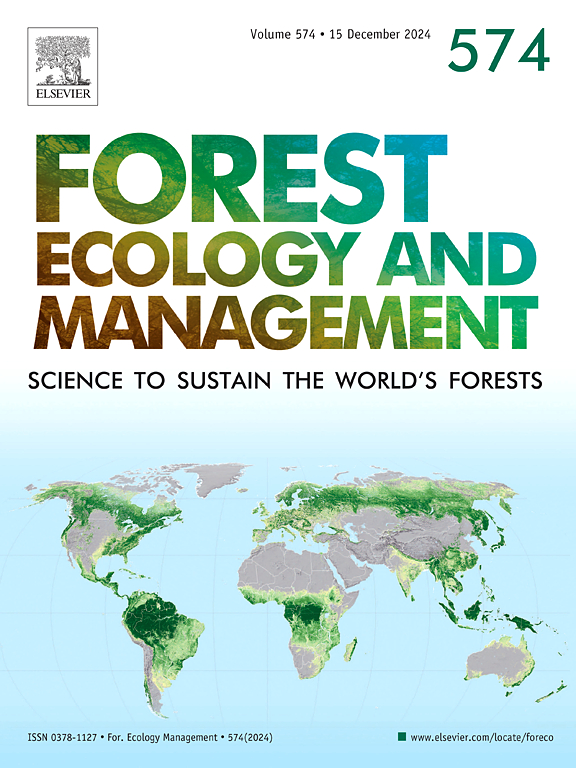Effects of leaf harvesting intensity on fruiting processes in three fodder tree species in the West African Savannah
IF 3.7
2区 农林科学
Q1 FORESTRY
引用次数: 0
Abstract
Leaf harvesting from fodder trees is one of the major forms of forest disturbance in West Africa, and its frequency is increasing in the wake of climate change. The impacts of leaf harvesting on fruits appearance of Afzelia africana Smith ex Pers., Khaya senegalensis (Desr.) A. Juss., and Pterocarpus erinaceus Poir, particularly in natural savannas, remain largely unexplored. This study explored three fodder species, (i) the minimum fruiting diameter, (ii) the time for the appearance of the first fruits after leaf harvest and (iii) the fruiting diameter most vulnerable to leaf harvest in two ecological zones in Benin. In total, 1040 individuals were examined, including 257 A. africana, 210 K. senegalensis, and 573 P. erinaceus from nine forest reserves in the Sudano-Guinean and Sudanian zones over three years (2021–2023). In the two ecological zones, the average diameters of the fruiting trees were 10 cm for K. senegalensis, 20 cm for P. erinaceus, and 15–20 cm for A. africana. The DBH, harvest intensity, and post-harvest duration were associated significantly with post-harvest fruit appearance. Low and medium leaf harvesting intensities did not prevent fruiting in the three species. Conversely, full leaf harvesting prevented fruiting in A. africana and K. senegalensis for at least two years, unlike in P. erinaceus, which fruited a year later. Stem shoot emergence in large-diameter trees in all three species, which facilitates fruiting, was impaired after leaf harvesting. Considering the results, leaf harvest intensities greater than 75 % should be discouraged to allow the three species to fruit each season to ensure seed availability for natural regeneration.
求助全文
约1分钟内获得全文
求助全文
来源期刊

Forest Ecology and Management
农林科学-林学
CiteScore
7.50
自引率
10.80%
发文量
665
审稿时长
39 days
期刊介绍:
Forest Ecology and Management publishes scientific articles linking forest ecology with forest management, focusing on the application of biological, ecological and social knowledge to the management and conservation of plantations and natural forests. The scope of the journal includes all forest ecosystems of the world.
A peer-review process ensures the quality and international interest of the manuscripts accepted for publication. The journal encourages communication between scientists in disparate fields who share a common interest in ecology and forest management, bridging the gap between research workers and forest managers.
We encourage submission of papers that will have the strongest interest and value to the Journal''s international readership. Some key features of papers with strong interest include:
1. Clear connections between the ecology and management of forests;
2. Novel ideas or approaches to important challenges in forest ecology and management;
3. Studies that address a population of interest beyond the scale of single research sites, Three key points in the design of forest experiments, Forest Ecology and Management 255 (2008) 2022-2023);
4. Review Articles on timely, important topics. Authors are welcome to contact one of the editors to discuss the suitability of a potential review manuscript.
The Journal encourages proposals for special issues examining important areas of forest ecology and management. Potential guest editors should contact any of the Editors to begin discussions about topics, potential papers, and other details.
 求助内容:
求助内容: 应助结果提醒方式:
应助结果提醒方式:


